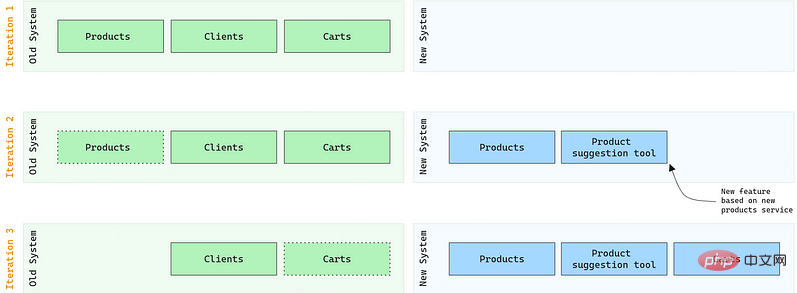Home >Technology peripherals >It Industry >Architecture pattern: Strangler pattern
Architecture pattern: Strangler pattern
- DDDOriginal
- 2023-11-16 10:48:031210browse
The Strangler pattern is a software architecture pattern first described by Martin Fowler. It describes an elegant approach to system migration step by step rather than all at once. It's named after the Strangler Fig, a vine that slowly climbs the tree and eventually takes its place. Similarly, in a software environment, the Strangler pattern involves building a new system around the boundaries of the old system, allowing you to gradually replace parts of the old system with components of the new system.
Many software engineers will face the problem of system migration during their careers; technology moves quickly, people need time to adapt to and maintain their systems, and sometimes systems become obsolete before they are even completed. The Strangler pattern is an approach that allows migration without having to make one-time, large-scale changes, which can be very stressful for teams and often doomed to failure. In the context of large systems, this pattern works very well because it allows one to gain confidence in the ability to migrate, providing many small successes that are more difficult to achieve in a one-time migration.
The general approach is to identify areas of the old system that can be replaced, and then gradually route new requests or functionality to the new system. Meanwhile, the old system still handles the old functionality. As the new system becomes more robust and functional, more and more functionality is moved to the new system until the old system can be safely phased out.

Benefits
Incremental migration: Compared to a high-risk full rollout, you can Migrate to a new system and make sure new components are working properly before continuing.
Reduce risk: Reduce the risk associated with major changes by breaking migrations into smaller, manageable chunks.
Maintain business continuity: During the migration process, businesses can continue to use existing systems, ensuring there is no loss of functionality or downtime.
Facilitates modernization: This pattern is particularly useful when transitioning from a monolithic architecture to microservices, because you can gradually replace monolithic components with microservices.
Flexibility: Because the migration is gradual, the team can make adjustments and improvements based on feedback from early migration stages. It also applies to modern software development methods, such as agile iterative methods.
Parallel Development: While developing a new system, changes can still be made to the old system if needed.
Stakeholder Trust: Migration is often a big deal for IT teams, especially since they represent a huge investment with hard-to-measure returns. If accepted, small signs of dysfunction may worry everyone because from their perspective, it is a high-risk situation. In a peculiar pattern, with smaller blocks, the pressure may be more localized to a specific block or group of blocks. This is very helpful in managing pressure at the top.
Focus on business value: By migrating only small parts, you can focus on the most important parts or the parts that would benefit most from the migration. By migrating small parts of a monolithic system, you can open up new business opportunities for your company, simplify key points, and more.
tradeoffs
Complexity: Managing two systems simultaneously can be complex. Ensuring compatibility, routing requests, and maintaining state between the two can be challenging.
Note: Consider the case of a modern centralized web application where a legacy system exists with an executable and multiple local databases. Reconciling and versioning the database will be very challenging.
Resource-intensive: Old and new systems may need to run simultaneously, requiring additional infrastructure and maintenance resources.
Possible drift: As development proceeds, there may be a risk that the new system will drift in terms of functionality or functionality from the old system, especially if changes continue to be made to the legacy system.
Duration: Transition can take a long time, especially for large, deeply integrated systems. This long transition period can result in increased costs and resource allocation for the migration.
Team Collaboration: To ensure successful implementation of Exotic Mode, the team needs to agree on goals, understanding of legacy systems, and migration strategies.
Conclusion
In a world where change is the only constant, Strangler patternbecomes an integral part of the evolution of management software systems an eye-catching method. By allowing for the incremental replacement of components of legacy systems, this pattern provides a strategic roadmap for organizations to navigate the complexities of technological advancement.
The incremental nature of the pattern aligns with contemporary agile practices, enabling teams to adapt, inspect, and adjust during the migration process. Not only does this maintain business continuity, it also fosters stakeholder trust by demonstrating continued progress and reducing the anxiety associated with large-scale system transformations.
However, Strangler Mode is not without its challenges. The complexity of operating and gradually transitioning between the two systems cannot be underestimated. It requires a disciplined approach to coordination, thorough testing, and a keen eye to maintain the balance of necessary functionality.
The key to successfully implementing the Strangler Pattern lies in careful planning, clear communication, and a deployment phase approach that prioritizes business value. It’s an exercise in balancing – between old and new, speed and stability, and investment and return.
As software engineers, the Strangler Pattern provides us with a pragmatic framework to ensure that our systems can evolve without disrupting the important services they provide. In the life cycle of software, Strangler pattern is not only a method of system migration, it is also a reflection of the evolutionary nature of the technology itself. Its purpose is to ensure that as our software matures, it continues to support changing business needs, remaining strong, relevant and resilient in the face of change.
The above is the detailed content of Architecture pattern: Strangler pattern. For more information, please follow other related articles on the PHP Chinese website!

